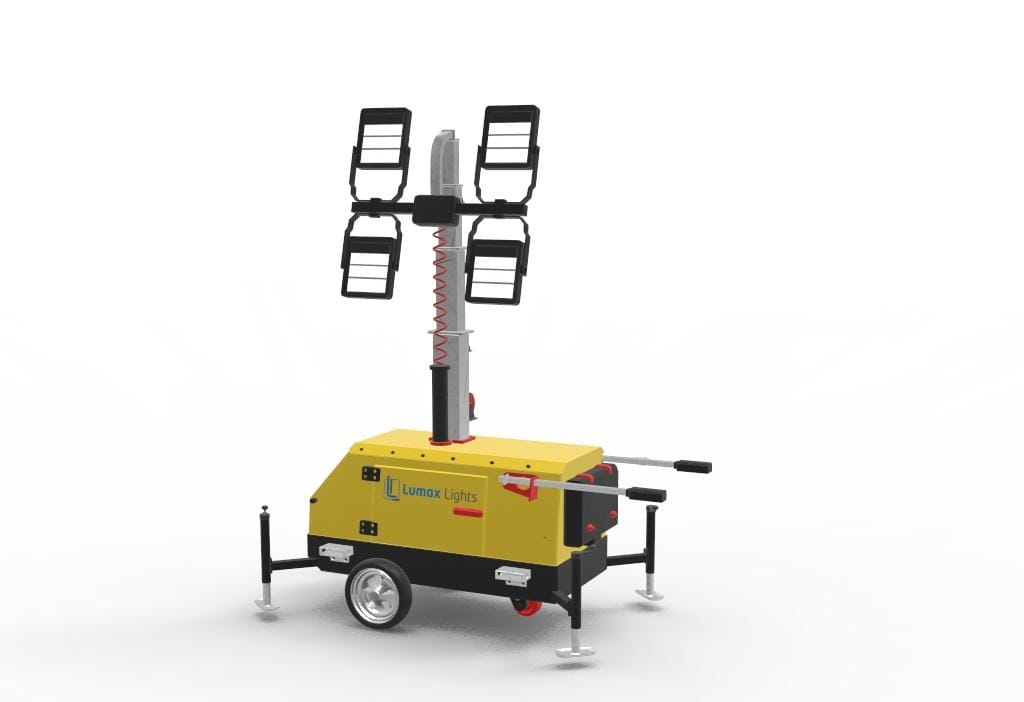Light Tower
Light towers are portable lighting solutions, generally used for, but not limited to, remote outdoor lighting for night-time operations. It is an elegant lighting solution for construction sites, mining, and other places where conventional lighting solutions like street lamps are not available or are not able to fulfil the requirements.
The major components of the light tower include:
Generator: For power supply;
Chassis: To carry the entire assembly;
Mast: Pole or tower-like structure for lifting light fixtures to varied heights according to requirement;
Lights: They are responsible for lighting the required area. These are attached to the mast and can be LED’s, metal halide lamps, etc. The lights on the mast can be adjusted to provide lighting at the exact desired location, making it easier for workers to complete their tasks.

Generator:
These are devices used to provide the electric power supply. They provide regulated voltage to the lights. They are off-grid power supply units, meaning that they are not dependent on power supply lines for power generation, instead, they are usually powered by an engine or batteries. Hence, they are ideal for application in remote locations like road construction, mining, etc. Generators can even be powered by solar energy.
Generators have two main components:
- Rotor- The part which rotates and is connected to the engine
- Stator- The part which remains stationary and is fixed to the frame
Chassis:
One of the major advantages of light towers is that they are mobile, making them usable for a variety of applications. The chassis is a structure fitted with wheels for movement, which carries the entire assembly of a light tower, including the generator, mast, light fixtures, electrical fitting, etc. The chassis can be designed specifically for a particular application, depending upon various factors like mast height, size of the generator, overall weight and size, etc.
Mast:
This is the structure that is responsible for lifting lights to varying heights, depending upon the requirement. The mast extends vertically upwards and can rotate to light the required area. They are usually retractable steel structures but can be inflatable balloon structures used for emergency applications.
Lights:
They are the most important components of light towers, as they are responsible to provide lighting at the required location. Hence, careful selection of lights is of utmost importance. Lights are affixed to the mast and can be adjusted to provide lighting at the exact desired location, making it easier for workers to complete their tasks. Lights are powered by the generator. Various aspects of lights have to be considered for any given application. These aspects include wattage, operating voltage, efficiency, service life, output parameters like lumens and lumens per watts, etc. Most commonly used lights for light towers include:
- Metal halide bulbs
- Halogen lights
- LED lights
Applications of light towers:
Being mobile and portable lighting units, light towers have a wide range of applications. Some of them include:
- Road construction: Workers at road construction sites need artificial lights for night time work, and the lights must be mobile since road construction requires movement.
- Mining industry: Since miners work in mines which do not receive natural light, they have to be dependent on an artificial light source, which should also be portable.
- Outdoor events: Outdoor events that take place at night time require portable lighting.
- Indoor industrial application
Parameters for selection of light tower:
- Power requirement
- Illumination requirement
- Lift height
- Beam angle
- Colour of light
- Runtime
- Economical and efficient
- Wind stability
- Weight and dimensions
- Noise level
- Chassis selection
- Mast rotation
Learn about Mining LED Light Towers